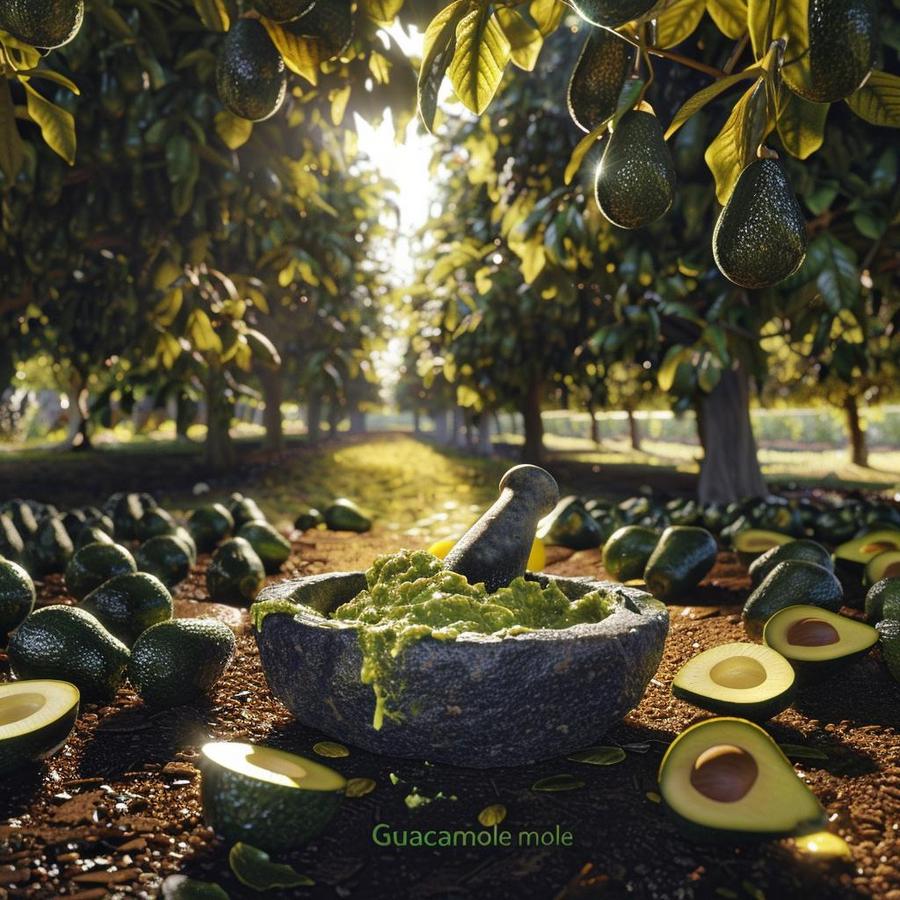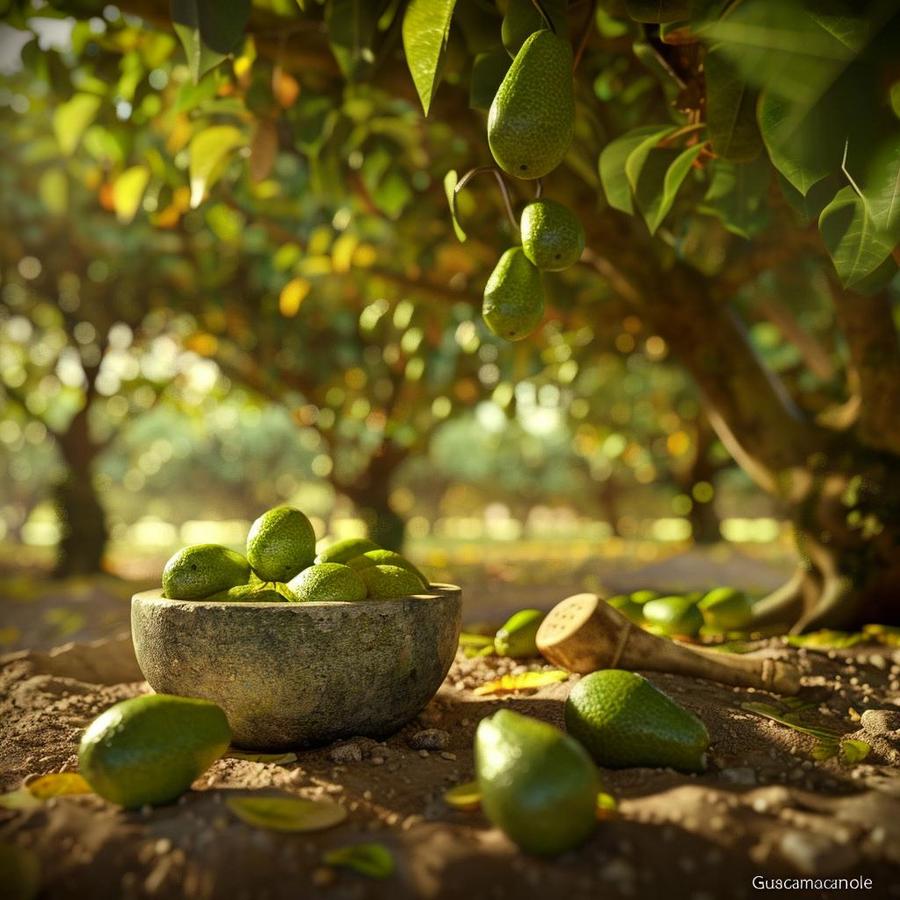Ever wondered about the roots of your favorite green dip? Prepare to dive into the exciting history and linguistic journey of the word ‘Guacamole’. This culinary term, loaded with tradition and flavor, unveils fascinating insights into culture, gastronomy, and language evolution. So tie on your apron, and let’s embark on this intriguing expedition exploring the etymology of ‘Guacamole’!
TL;DR:
- The term 'guacamole' originates from the Aztec word 'āhuacamōlli', meaning 'avocado sauce', showcasing a rich Mexican cultural heritage.
- While the meaning of 'guacamole' hasn't greatly changed, the dish is now seen as an emblem of Mexican cuisine and global culinary delight.
- Traditional guacamole consists of avocado, salt, lime juice, cilantro, onions, and jalapeños; regional variations may include additional ingredients.
- Making guacamole involves mashing ripe avocado and mixing in other ingredients for a blend of tastes and textures.
- Guacamole has garnered global popularity due to its simplicity, versatility, and the health benefits of avocado, leading to various unique adaptations worldwide.

What is the origin of the word Guacamole?
Guacamole's history traces back to the ancient Aztecs, linked to the word 'āhuacamōlli.' Comprising 'āhuacatl' (avocado) plus 'mōlli' (sauce), it translated as 'avocado sauce.' Nahuatl, the language of Aztecs, gave us this rich term.
How did the word Guacamole evolve over time?
Through time and place, 'āhuacamōlli' morphed into the term we know today – guacamole. The transformation saw it adapt to fit different tongues and cultures, from the original Nahuatl pronunciation to the Spanish-influenced word we now use, a clear case of linguistic evolution over centuries.
What is the linguistic root of Guacamole?
The linguistic root of guacamole lies in the Aztec's Nahuatl language. The word was birthed from a rich cultural heritage rooted in Mexico, showcasing the influences of a time when food was not just sustenance, but also a form of symbolic communication.
How has the meaning of the word Guacamole changed over time?
In essence, guacamole's meaning has not greatly shifted since it was first used. It remains 'avocado sauce' as per its original definition, a tribute to the staple ingredients and the ancient method of making this popular dish. However, over time, the social images it evokes have certainly expanded, from basic food to an emblem of Mexican cuisine and a symbol of festivity and global culinary delight.
Remember, whether it's a laid-back gathering, a party snack, or simply a meal for yourself, this creamy, crunchy and piquant guacamole will always have a story within – a tale of the merging of diverse cultures, language evolution, and a time-honored recipe still beloved around the world.
What are the key ingredients in traditional Guacamole?
The lead star in guacamole is the avocado. Originating from Mexico, this creamy green fruit is what gives guacamole its prime base. The avocado's rich and buttery nature offers a unique flavor profile that's both refreshing and indulgent, a true testament to the origins of guacamole.
What makes the avocado the star ingredient in Guacamole?
Other than its lush texture and distinct taste, avocados also score high on nutrition. They pack in a wealth of vitamins, minerals, dietary fiber, and healthy fats, making them a prime choice for health-conscious foodies.
Pair avocado with a sprinkle of salt, and you create an addictive salty and savory element. Yet guacamole doesn't end here. The history of avocado dip shows that a blend of additional ingredients combines to craft this classic dish.
How do the other ingredients complement the avocado?
Traditional guacamole mixes in lime juice, cilantro, onions, and jalapeños. Lime adds a tangy contrast to the creamy avocado, while cilantro imparts a fresh, citrusy touch. Onions provide a crunchy texture and a sharp flavor. Lastly, jalapeños bring a kick of heat for those who prefer a bit of zing to their dips. Together, these elements contribute to an exciting play on flavors and textures in every spoonful.
Are there variations in the ingredients used across regions?
Just like with any dish beloved by many, guacamole has seen its share of adaptations. Some versions might include sour cream for added creaminess, tomatoes to introduce a sweet and tangy flavor, or even peas for a fun twist. Avocado sauce history revealed that its versatile nature lends itself perfectly to experimentation.
While the traditional ingredients will stay the same for purists, these regional variations certainly make every guacamole experience an exciting one. Every variation falling under the vast umbrella of guacamole origins helps make the dish as vibrant and globally loved as it is today.
Related Recipes:

What is the traditional method of preparing Guacamole?
Roll up your sleeves and get ready to dive into the art of guacamole crafting. Yes, crafting! Because tradition has it that guacamole was once, and still can be, a labor of love.
The core staple of this delicious dip is the ripe avocado. An art exists in selecting the perfect avocado that strikes the balance between firm and mushy. The deftness of your touch is in wielding a knife to slice open this fruit, removing the wily pit and scooping out the buttery flesh!
The next step is mashing the avocado in a molcajete, made from volcanic rock. This is a traditional Mexican mortar and pestle. Salt is often the first seasoning, crushed into the avocado. Guacamole linguistic roots dictate the use of this tool, for the word itself is in respect to the method.
For that tangy punch, fresh lime juice is squeezed into the mix. Next comes the crunch factor, introduced in the form of finely chopped onions and cilantro. Then for the brave ones, spice comes to life with chopped jalapeños. Remember, the heat lies in the ribs and seeds.
This traditional method does more than just blend flavors. It creates a creamy yet chunky texture, a sensory delight. Plus, you might discover a biceps workout you never knew existed!
Looking to master the perfect guacamole? It's in the simplicity of the ingredients and the rusticity of the method. Keep your avocados ripe and your limes fresh. From there, your tweaks will make your guacamole a masterpiece of your own.
Just allow yourself to revel in the guacamole word history, the very process, tactile, aromatic and appetizing. After all, who knew the path to culinary glory lay in a ripe avocado and a trusty molcajete!
How has Guacamole evolved and spread globally?
Curiosity begs a question. Where does guacamole come from? Digging into guacamole word origins, we uncover Mexico as the birthplace. Here, the historic Aztec people created this delicious dip. But how did this Mexican gem navigate to global acclaim?
The avocado sauce history enlightens us. English pirate William Dampier, credited with introducing the avocado to the English-speaking world in the 17th century, might have set the stone rolling, amplified later by Mexican immigrants in the United States. From the US, this luscious green dip hopped, skipped, and jumped across borders, transforming into a global sensation.
How has Guacamole adapted to different cultures and palates worldwide?
As guacamole found new homes, it had to adapt to diverse palates. In the United States, guacamole became a beloved component of Tex-Mex cuisine, often mixed with sour cream for a creamier texture. Across the Atlantic, in Spain and the UK, guacamole found itself sometimes mashed with peas. All these adaptations keep the spirit of the guacamole word evolution alive.
Why has Guacamole become a popular global dish?
The popularity of guacamole lies in its simplicity and versatility. Basic ingredients, easily adaptable to personal taste, make it a hit. More so, the health benefits of avocado, the star ingredient, have also contributed towards guacamole’s fame in health-conscious circles.
What are some interesting adaptations of Guacamole?
From the basic recipe, guacamole has seen countless adaptations. Countries like Israel introduced pomegranate seeds, transforming not just its taste and texture but also its appearance. Back in Japan, the umami-rich wasabi replaced jalapenos to create a unique fusion. Different and exciting, they prove that guacamole is not just a dish, it’s an experience always ready to unfold anew! Thus goes the story of this humble avocado dip’s journey from its Mexican roots to its global fanfare.
In this post, you've learned about the rich history and evolution of guacamole, from its linguistic roots to its global acceptance. We've explored its ingredients, and their significance, and even delved into traditional preparation methods for that perfect guacamole. Lastly, we showed how guacamole has spread across the globe, adapting to numerous cultures and tastes. No matter where you travel, guacamole represents a blend of tradition, taste, and global culinary friendship. Keep exploring and adding a touch of guacamole goodness to your dishes!



